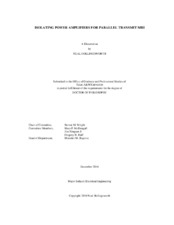| dc.contributor.advisor | Wright, Steven M | |
| dc.creator | Hollingsworth, Neal Anthony | |
| dc.date.accessioned | 2017-03-02T16:50:00Z | |
| dc.date.available | 2018-12-01T07:20:26Z | |
| dc.date.created | 2016-12 | |
| dc.date.issued | 2016-12-09 | |
| dc.date.submitted | December 2016 | |
| dc.identifier.uri | https://hdl.handle.net/1969.1/159070 | |
| dc.description.abstract | A radio frequency parallel transmitter was developed for magnetic resonance imaging. Eight channels of vector modulation and isolating power amplifiers were constructed so that the performance of different amplifier architectures could be investigated. An eight channel system was implemented and tested using both quantitative bench measurements and imaging experiments. The imaging experiments were performed on three separate MR systems at 3T, 4.7T, and 7T at different sites using both B1 shimming and fast modulation techniques.
The modulation system implemented is based on vector modulators in order to simplify integration with existing MRI systems. Current Source and Low Output Impedance amplifiers were built and compared in terms of theory of operation, their ability to isolate array coils, and the amount of power they can deliver to a coil. The current source amplifiers function by introducing a high impedance in series with the coil which is series resonant. In contrast, the low output impedance amplifiers present a low impedance to the coil which has a matching network that forms a parallel resonant tank. Both are able to provide isolation, with the current source amplifiers producing in excess of 30dB of isolation and low output impedance amplifiers providing approximately 12.5dB in practical situations. The current source amplifiers can only produce approximately 10A (or between 150W and 300W) of output power because they are not power matched. In contrast, the low output impedance amplifiers can produce roughly 1kW (the device rating) because they are power matched. Ultimately, there is no single best architecture of power amplifiers at this time. Standard amplifiers are useful when only one or two transmit channels are needed and broad-bandedness is valuable. Current source amplifiers are best suited to situations where very high channel counts are needed because of their high isolation. Low output impedance amplifiers are most useful with moderate channel counts because they provide some isolation at moderately high powers. | en |
| dc.format.mimetype | application/pdf | |
| dc.language.iso | en | |
| dc.subject | RF Amplifiers | en |
| dc.subject | MRI | en |
| dc.subject | Parallel Transmit | en |
| dc.subject | Isolating Amplifiers | en |
| dc.title | Isolating Power Amplifiers for Parallel Transmit MRI | en |
| dc.type | Thesis | en |
| thesis.degree.department | Electrical and Computer Engineering | en |
| thesis.degree.discipline | Electrical Engineering | en |
| thesis.degree.grantor | Texas A & M University | en |
| thesis.degree.name | Doctor of Philosophy | en |
| thesis.degree.level | Doctoral | en |
| dc.contributor.committeeMember | McDougall, Mary P | |
| dc.contributor.committeeMember | Ji, Jim X | |
| dc.contributor.committeeMember | Huff, Gregory H | |
| dc.type.material | text | en |
| dc.date.updated | 2017-03-02T16:50:00Z | |
| local.embargo.terms | 2018-12-01 | |
| local.etdauthor.orcid | 0000-0003-2195-0649 | |


